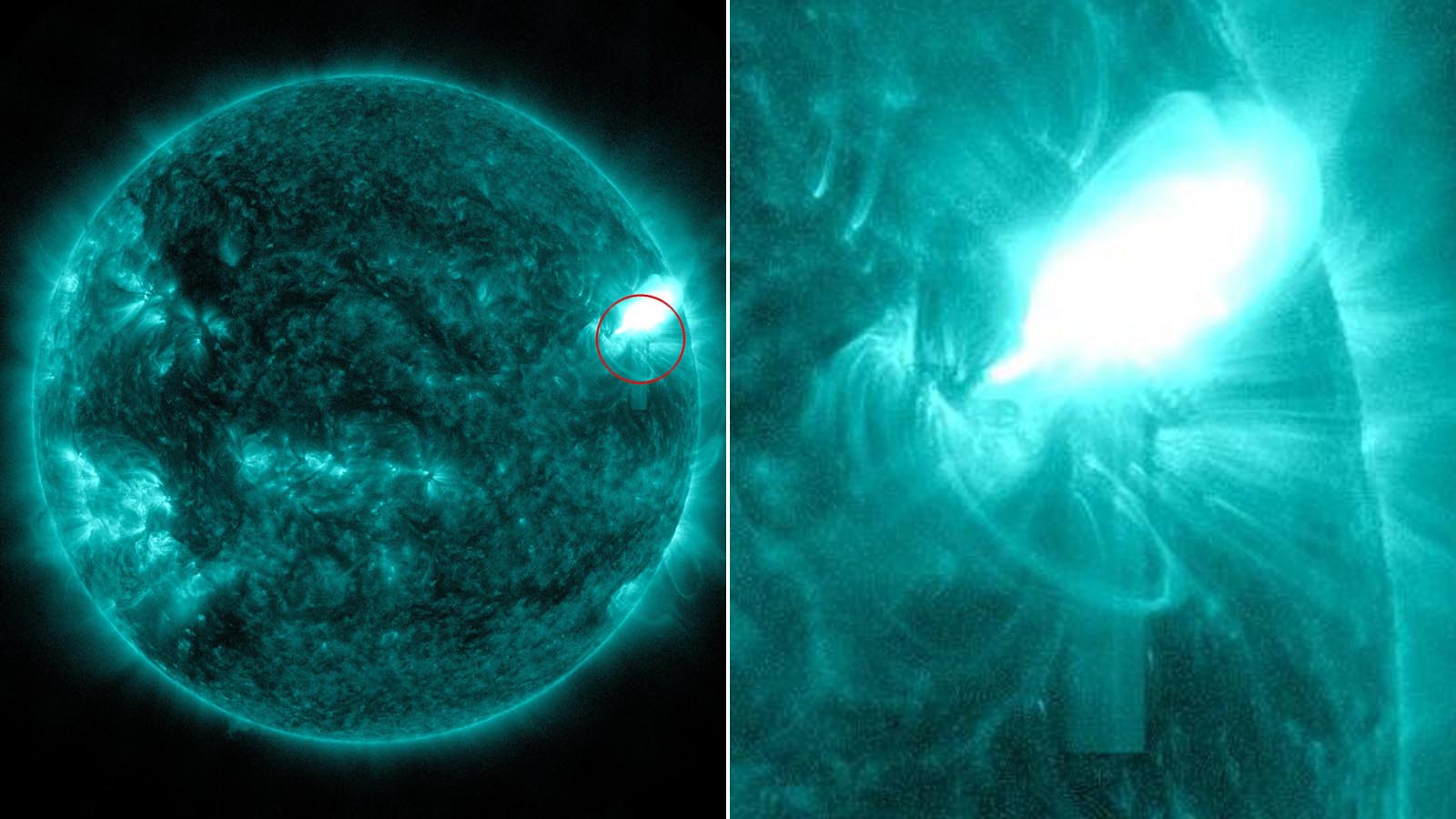An unusually powerful X-class solar flare erupted from the sun’s surface on Sunday, causing radio blackouts across the western United States and the Pacific Ocean.
The solar flare was spat out at 23:14 UT (7:14 p.m. ET) from sunspot AR3354, a large sunspot that had developed a “beta-gamma-delta” magnetic field primed with enough energy to produce this kind of powerful solar flare.
The solar flare’s X-rays ionized the upper atmosphere, leading to a deep shortwave radio blackout across the west of the U.S., with mariners and ham radio operators having possibly lost signal for around half an hour after the flare hit, spaceweather.com reported.
Solar flares are powerful bursts of X-ray electromagnetic radiation, usually emitted from sunspots with intense magnetic energy. These flares are often released at the same time as eruptions of solar plasma, known as coronal mass ejections or CMEs.
The solar flare recorded on the Sun was rated as “X1.08,” meaning it ranks at the weaker end of the strongest flares that the sun produces. X-class flares only occur around 10 times each year.
“Solar flares are classified according to how bright they are in the soft X-ray part of the spectrum,” Gonzalo José Carracedo Carballal, an astrophysics researcher at the Instituto Nacional de Técnica Aeroespacial in Madrid, Spain, previously told Newsweek.
“The weakest are the A-class flares, followed in intensity by the B-class, C-class, M-class—these are ‘moderate’—and the X-class,” he said.
Within each class, the solar flares are classed on a scale between 1 and 9, with only X-class flares being able to go above a score of 9. Each class represents a flare 10 times stronger than the previous number, with an X1 flare being 10 times more powerful than an M1, and 100 times more powerful than a C1.
This solar flare was triggered after a plasma plume hit the sunspot, with the hot magnetized gas stimulating the flare to burst forth.
Major X1.08 flare from sunspot region 3354
Follow live on https://t.co/3Xxrvc3cpA pic.twitter.com/aoHtHOD3Xc— SpaceWeatherLive (@_SpaceWeather_) July 2, 2023
While A, B, and C-class flares usually have weak effects on the Earth, M-class flares can cause brief radio blackouts, and X-class flares can lead to more extensive and longer-lasting blackouts and radiation storms, impacting satellites and communication systems.
The reason that these flares cause radio blackouts is because they ionize the Earth’s ionosphere. High-frequency radio waves rely on the ionosphere to bounce signals between the sender and the receiver—if it’s been ionized, these radio waves are instead degraded or are completely absorbed.
“The emissions of X-rays ionize the lower ionosphere (the D-region, at altitudes close to 80-90 kilometers) (50-56 miles), which actually absorbs [high frequency] radio waves, thereby stopping them from continuing up to the higher ionosphere where they get bounced back towards the ground,” Brett Carter, an associate professor in space physics at RMIT University in Australia, told Newsweek in December.
“This absorption effectively causes the ‘radio blackout’…because the signals don’t reach their intended target(s).”
The main industry affected by these blackouts is civil aviation, as these aircraft usually use long-range communications over large remote areas or oceans with no ground-based radio networks.
“High-frequency is a primary method for aircraft in these areas to communicate with air traffic control. For example, flights over the North Atlantic will communicate with oceanic air traffic control centers provided by Canada, Iceland and U.K./Ireland,” Mike Hapgood, a space weather scientist at the STFC Rutherford Appleton Laboratory in the United Kingdom, previously told Newsweek.
“Many aircraft also have satcom as backup, but high-frequency is mandatory as part of international agreed procedures. So high-frequency blackouts can disrupt those links, but in general only for a few tens of minutes, so the industry can work around that disruption. These blackouts will not affect take-off and landing as aircraft will then use short-range VHF radio links.”
Luckily, this solar flare was relatively weak even for an X-class flare, and the effects lessened after a short time.
The largest and most powerful flare in recorded history is thought to have been the 1859 Carrington Event, which led to bright auroras and even fires in some telegraph stations. An equivalent flare today may cause widespread and expensive impacts to the electrical grid.
“An event similar to the Carrington Event happening today could result in between $0.6 and $2.6 trillion in damages to the U.S. alone, according to NASA spaceflight,” Rami Qahwaji, a visual computing professor at the University of Bradford, previously told Newsweek.
















Should read the book, Experiment Thrae. You will be surprised on the reality of the book!